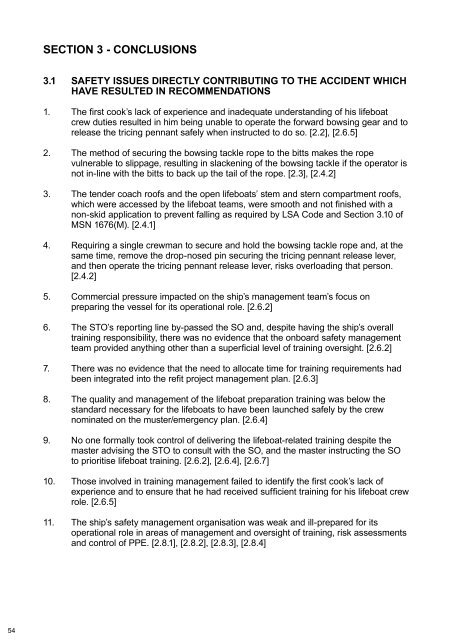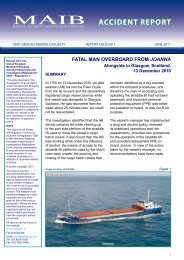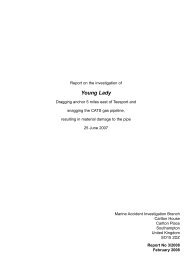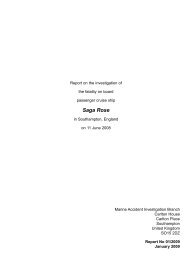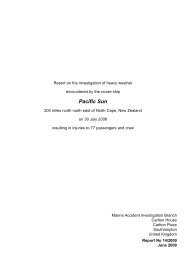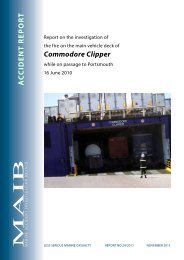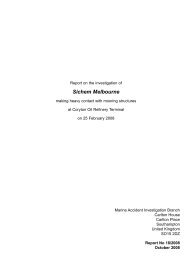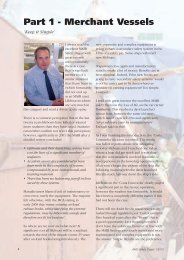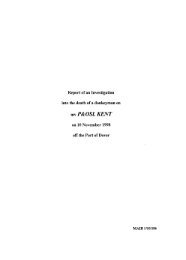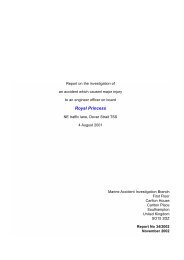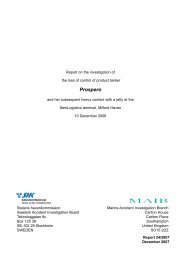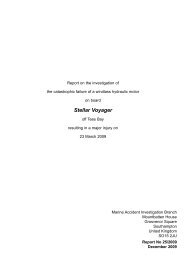SECTION 4 - Marine Accident Investigation Branch
SECTION 4 - Marine Accident Investigation Branch
SECTION 4 - Marine Accident Investigation Branch
Create successful ePaper yourself
Turn your PDF publications into a flip-book with our unique Google optimized e-Paper software.
54<br />
<strong>SECTION</strong> 3 - CONCLUSIONS<br />
3.1 SAFETY ISSUES DIRECTLY CONTRIBUTING TO THE ACCIDENT wHICH<br />
HAVE RESULTED IN RECOMMENDATIONS<br />
1. The first cook’s lack of experience and inadequate understanding of his lifeboat<br />
crew duties resulted in him being unable to operate the forward bowsing gear and to<br />
release the tricing pennant safely when instructed to do so. [2.2], [2.6.5]<br />
2. The method of securing the bowsing tackle rope to the bitts makes the rope<br />
vulnerable to slippage, resulting in slackening of the bowsing tackle if the operator is<br />
not in-line with the bitts to back up the tail of the rope. [2.3], [2.4.2]<br />
3. The tender coach roofs and the open lifeboats’ stem and stern compartment roofs,<br />
which were accessed by the lifeboat teams, were smooth and not finished with a<br />
non-skid application to prevent falling as required by LSA Code and Section 3.10 of<br />
MSN 1676(M). [2.4.1]<br />
4. Requiring a single crewman to secure and hold the bowsing tackle rope and, at the<br />
same time, remove the drop-nosed pin securing the tricing pennant release lever,<br />
and then operate the tricing pennant release lever, risks overloading that person.<br />
[2.4.2]<br />
5. Commercial pressure impacted on the ship’s management team’s focus on<br />
preparing the vessel for its operational role. [2.6.2]<br />
6. The STO’s reporting line by-passed the SO and, despite having the ship’s overall<br />
training responsibility, there was no evidence that the onboard safety management<br />
team provided anything other than a superficial level of training oversight. [2.6.2]<br />
7. There was no evidence that the need to allocate time for training requirements had<br />
been integrated into the refit project management plan. [2.6.3]<br />
8. The quality and management of the lifeboat preparation training was below the<br />
standard necessary for the lifeboats to have been launched safely by the crew<br />
nominated on the muster/emergency plan. [2.6.4]<br />
9. No one formally took control of delivering the lifeboat-related training despite the<br />
master advising the STO to consult with the SO, and the master instructing the SO<br />
to prioritise lifeboat training. [2.6.2], [2.6.4], [2.6.7]<br />
10. Those involved in training management failed to identify the first cook’s lack of<br />
experience and to ensure that he had received sufficient training for his lifeboat crew<br />
role. [2.6.5]<br />
11. The ship’s safety management organisation was weak and ill-prepared for its<br />
operational role in areas of management and oversight of training, risk assessments<br />
and control of PPE. [2.8.1], [2.8.2], [2.8.3], [2.8.4]


